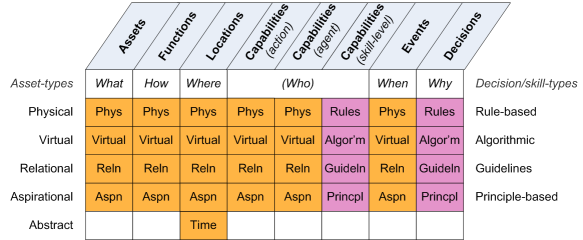Services and Enterprise Canvas review – Introduction
What are services? What’s the difference between product and service? How does a service-oriented architecture really work – especially when we scale it up to include everything in the entire enterprise? And how does the Enterprise Canvas model-type help in describing and mapping all of this?
These were questions that came up quite a bit during my recent ‘EA-Masterclass’ series in Australia, and, as mentioned in that follow-up article, it seems to me it’d be worthwhile to explore some of these themes again. In particular, I need to explain better two items that gave quite a bit of trouble to participants on the course: the roles of the ‘guidance-services’ – Coordination, Direction, Validation:
…and the use of the Service Content checklist:
But in fact there were quite a few other questions and confusions that came up as well, so I’ll split this into a brief(ish) six-part series:
- Core: what a service-oriented architecture is and does
- Supplier and customer: modelling inbound and outbound service-relationships
- Guidance-services: keeping the service on-track to need and purpose
- Layers: how we partition service-descriptions
- Service-content: looking inside the service ‘black-box’
- Exchanges: what passes between services, and why
A service-oriented approach to enterprise-architecture can enormously reduce the complexities, and Enterprise Canvas can in turn be enormously powerful as a metaframework to model and map out that architecture, and to guide discussions and explorations about that architecture. I’ll admit, though, that it is a different paradigm from the usual approaches to enterprise-architecture, and it does take a while to get the head around it – but I think you’ll find it well worth the effort?
Anyway, on with the show – starting with an exploration of the core ideas and concepts behind a whole-of-enterprise service-oriented architecture.


Leave a Reply